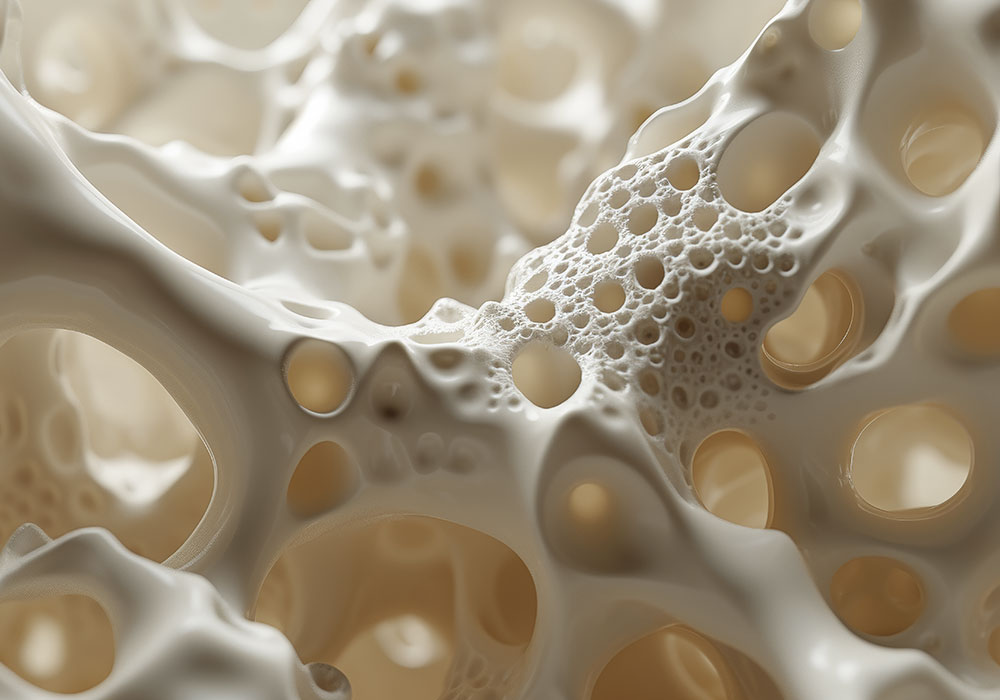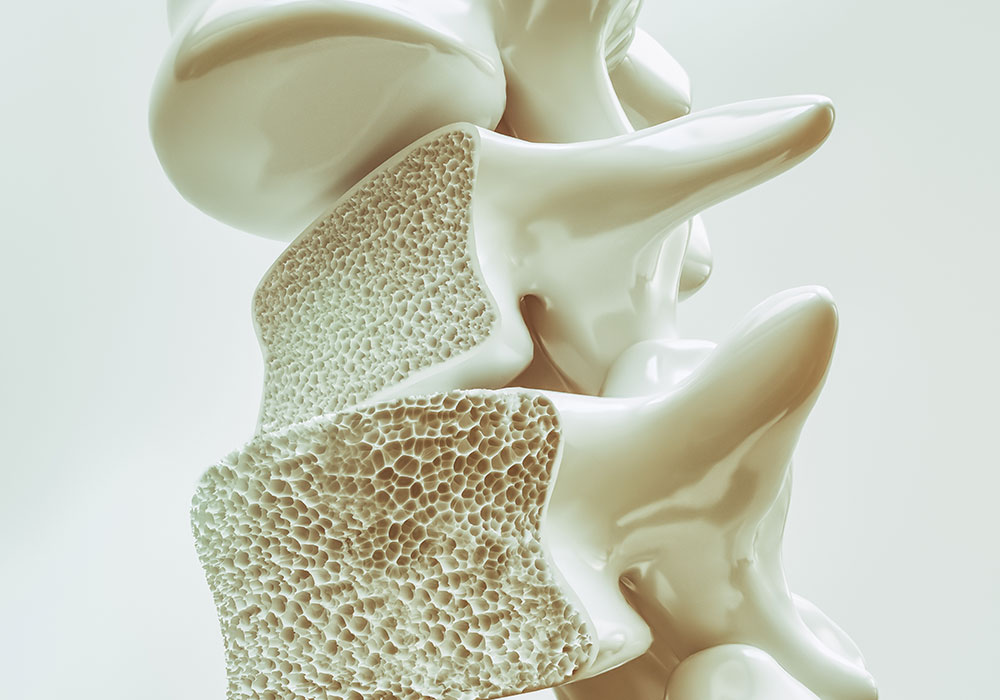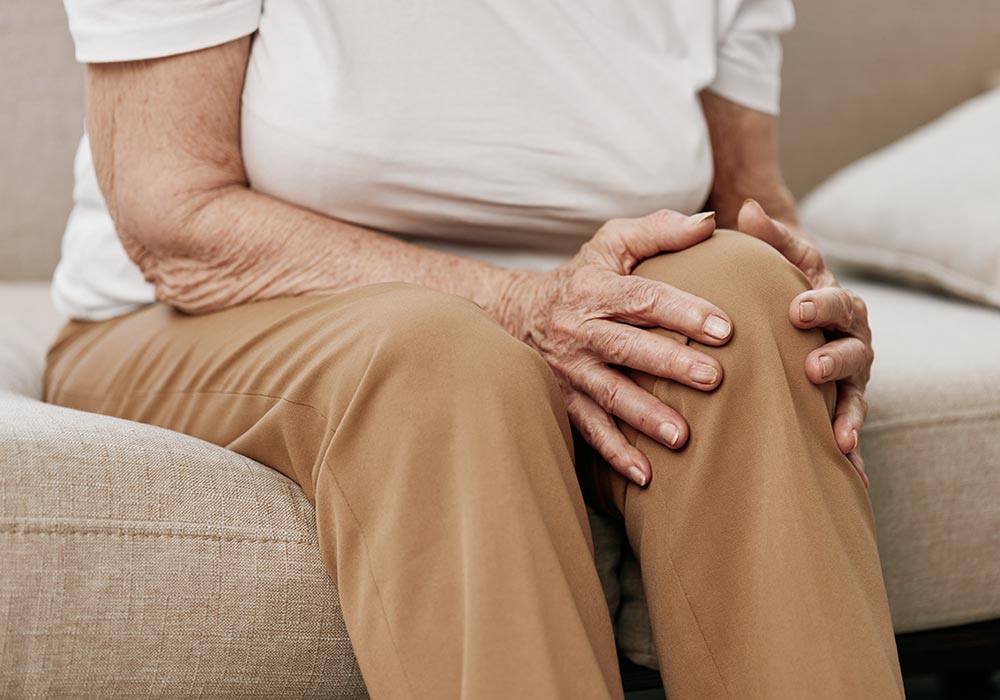Osteoporosis, a disease that is also known as the “silent thief of bones”. In the following, we explain what happens in your body when you have osteoporosis and whether the disease can be cured.
In principle, all visits to our private practice for orthopaedics & traumatology in Frankfurt are based on a detailed discussion about the cause, course, treatment options, etc. as well as a thorough physical examination. Only when the patient understands their clinical picture correctly can they support the treatment path with conviction.
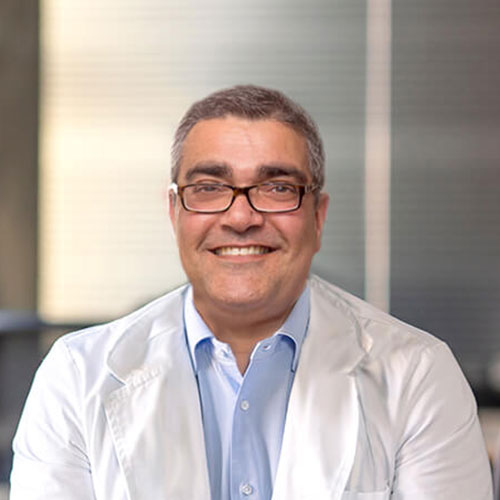
Dr. med. Nader Tabrizi

Dr. med. Stefan Chwalek
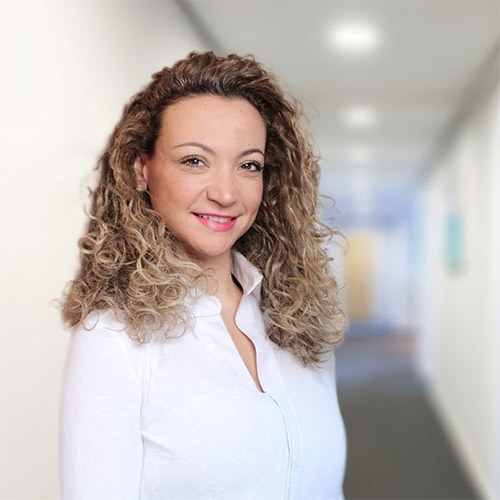
Dr. med. Isabella Gruber
Osteoporosis is a disease in which the bones lose density and strength. This makes them brittle and susceptible to fractures. Normally, the body continuously builds up and breaks down bone mass over the course of a lifetime. It does this to regulate bone mass and maintain bone structure. This so-called bone remodeling allows the body to remove damaged or old bone tissue and replace it with new, healthy tissue.
During the formation process (new bone formation), specialized cells – the so-called osteoblasts – are activated to form new bone tissue and increase bone mass. During the breakdown process (bone resorption), other specialized cells are at work. These so-called osteoclasts break down old or damaged bone tissue and reduce bone mass.
This dynamic process enables the bones to adapt to different loads and conditions while maintaining the structural integrity of the skeleton.
In osteoporosis, bone resorption greatly outweighs bone formation. This leads to a loss of bone mass. Causes include hormonal changes (especially in women after the menopause), malnutrition, insufficient physical activity, smoking and excessive alcohol consumption. These factors can accelerate normal bone loss and increase the risk of osteoporosis.
A healthy bone has optimal density and structure, which makes it strong and resistant to stress. A healthy lifestyle, which includes a balanced diet, exercise and avoiding harmful habits, supports bone health.
Disruptions to this process – e.g. due to hormonal changes or malnutrition – can lead to an imbalance in which bone resorption outweighs bone growth. The result is a loss of bone mass and density: osteoporosis.
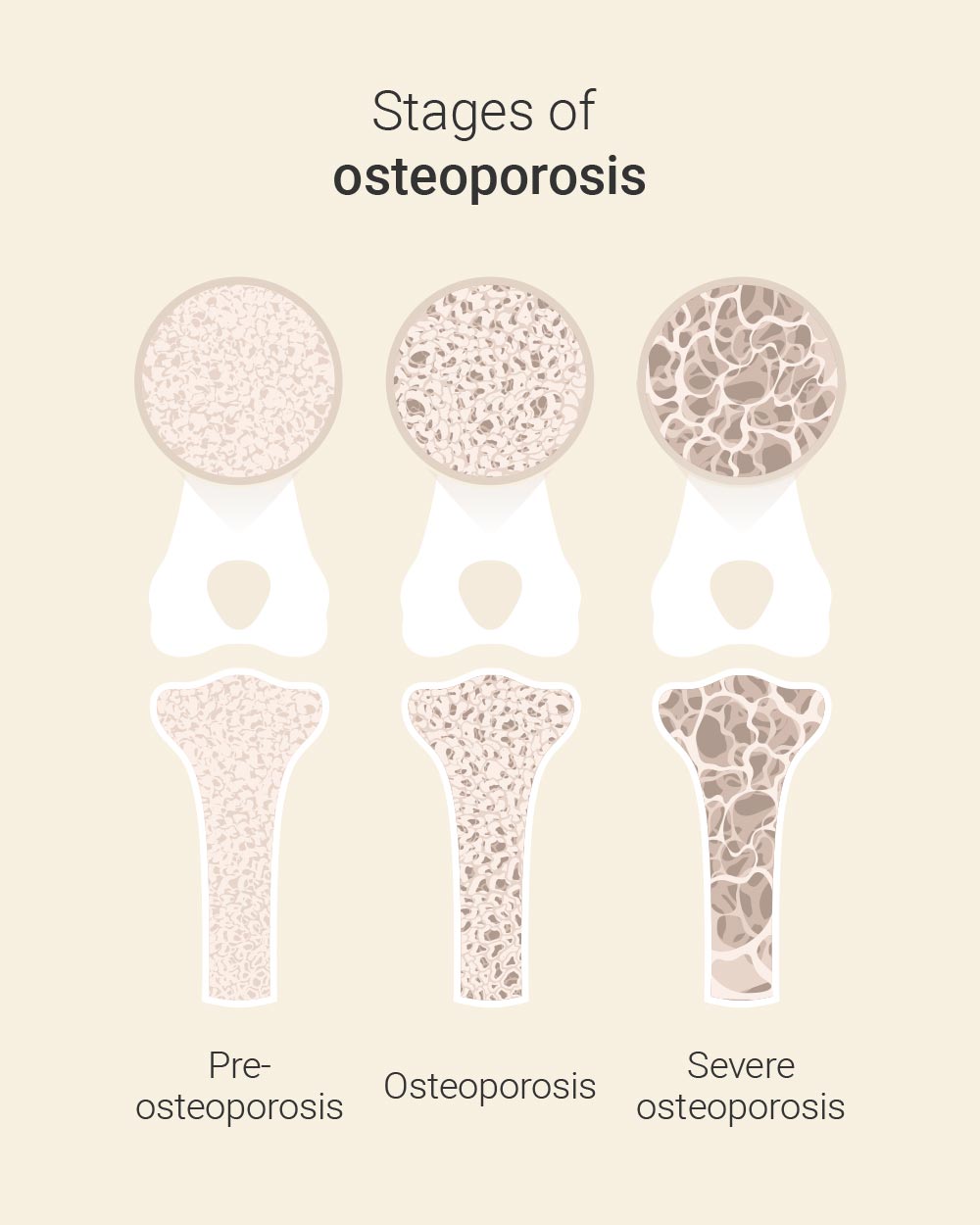
There are three stages that describe the severity and progression of the disease:
Pre-osteoporosis (osteopenia)
In this early stage of bone weakness, bone mineral density is lower than normal. However, it is not sufficient to fulfill the diagnosis of osteoporosis. People with osteopenia have an increased risk of developing osteoporosis in the future. It is an important stage to take preventative measures to slow the progression of the disease. At our private practice for orthopaedics and traumatology in Frankfurt, we will be happy to examine you and advise you on possible preventive measures.
Osteoporosis
At this stage, the bone mass has continued to decrease. As a result, the bones are weak and brittle. The risk of fractures, particularly in the spine, hips and wrists, is increased. This is where appropriate osteoporosis treatment is important, which we offer at our practice in Frankfurt.
Severe osteoporosis
At this advanced stage, bone mass is greatly reduced. The risk of serious bone fractures is high. The impact on health and quality of life can be significant, as fractures can lead to pain, disability and other complications. Here too, we recommend comprehensive treatment in our practice.
Common symptoms of osteoporosis are loss of bone density and height, easily occurring fractures, reduced mobility and back pain.
There are certain other symptoms that can be associated with osteoporosis:
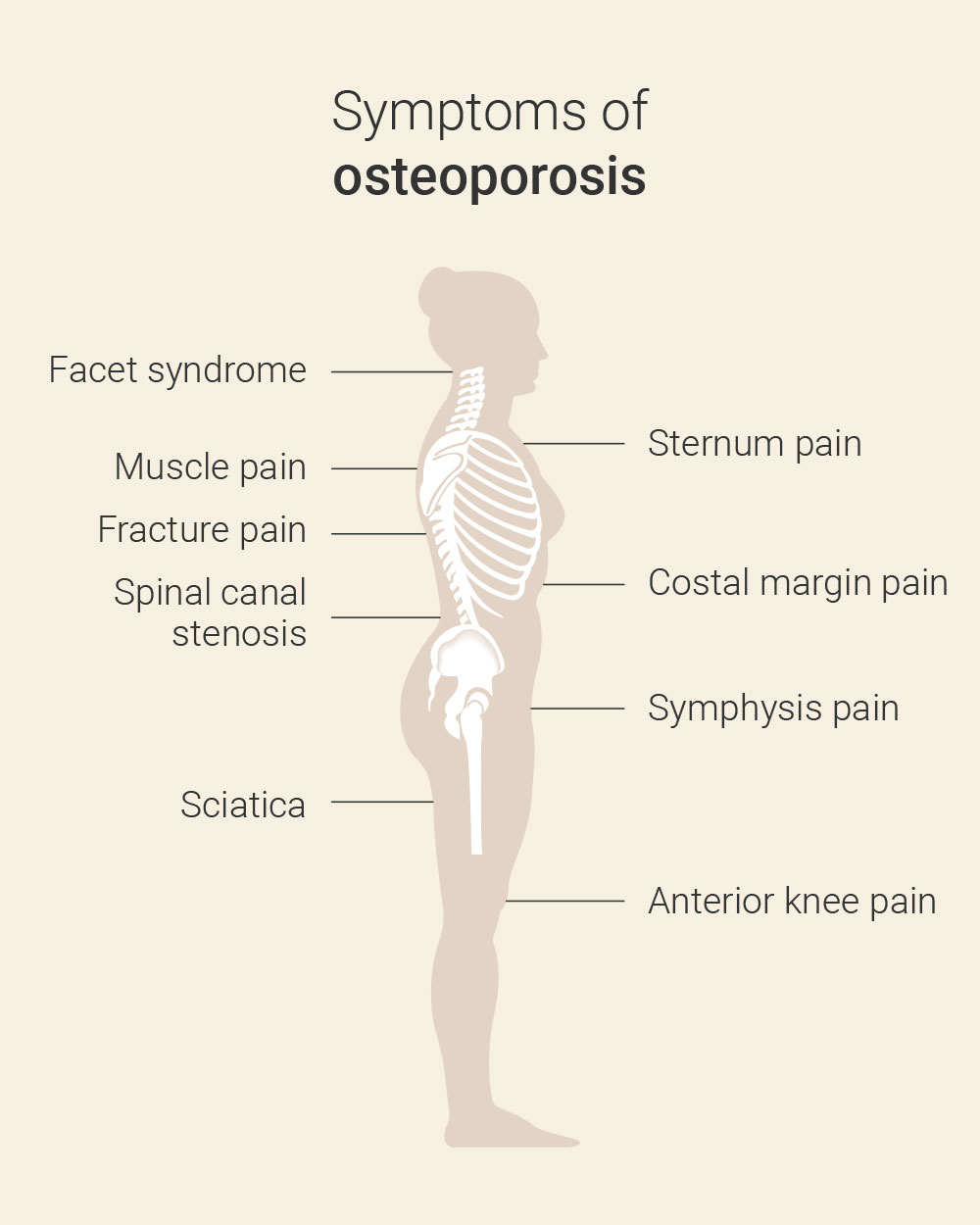
Facet syndrome
Facet syndrome is a condition that often occurs in connection with osteoporosis. It affects the small joints on the vertebral bodies (facet joints). They play an important role in the mobility of the spine and support the stability of the vertebrae. In osteoporosis, bone loss can lead to a change in the structure and function of the spine. One possible consequence: the facet joints wear out or degenerate. This can lead to inflammation, restricted movement and even stiffness. Pain associated with facet syndrome can also radiate to other areas of the body, such as the legs.
Muscle pain
Osteoporosis can affect posture and mobility, especially when vertebrae are affected. To compensate for these changes, certain muscles have to work harder, which can lead to overloading and consequently to muscle pain. This is also possible in the opposite case, when osteoporosis causes stiffness. This often results in painful muscle tension.
Sternum pain
The sternum is a flat bone in the centre of the chest. The sternum plays an important role in protecting the internal organs. It also serves as a connection point for the ribs. When bone density decreases due to osteoporosis, the sternum can become more susceptible to fractures (e.g. due to sudden movements, impact or pressure). A fracture of the sternum can cause pain in the chest area, which can worsen when you cough, take a deep breath or move.
Pain at the edge of the ribcage
Osteoporosis usually also causes bone loss in the ribs. This can make them more fragile. Fractures can occur along the lower edge of the ribs. This is accompanied by pain along the edge of the ribcage. It is often worse when coughing, sneezing, deep breathing and certain movements that put pressure on the affected area.
Spinal canal stenosis
In osteoporosis, bone loss can lead to instability of the vertebrae and degenerative changes in the spine. This can cause bony outgrowths (osteophytes/bone growths). These can narrow the space in the spinal canal. In addition, vertebral bodies can contract or collapse as a result of osteoporosis. This can also contribute to a narrowing of the spinal canal. Spinal canal stenosis is usually accompanied by back pain, leg pain, numbness, tingling, weakness and gait disorders. These symptoms can worsen if the nerve roots in the spinal canal also feel constricted.
Symphysis pain
This is pain that can occur in the area of the symphysis ligament. This is a structural connection between the two pubic bones. It serves to stabilise the pelvis and distribute the load when walking, standing and other movements. In osteoporosis, bone loss in the pelvic area can lead to instability and changes in the symphysis. This manifests itself in pain and tenderness, especially if the ligament is overloaded or irritated. Stiffness in the pelvic area and restricted movement are also possible.
Sciatica
In some cases, osteoporosis also affects the sciatic nerve. This occurs when bone loss and degenerative changes irritate or compress it. Symptoms of sciatica in osteoporosis can include pain, numbness, tingling, muscle weakness and restricted movement in the buttocks, hip, thigh and/or leg.
Anterior knee pain
Patients may modify their posture and gait to avoid pain due to bone weakness and back problems. These changes can put additional pressure and strain on the knee, which can lead to anterior knee pain. This often leads to destabilisation of the knee joint and pain in the front of the knee.
Early detection of this widespread bone metabolism disorder, predominantly with the elderly patient is necessary in order to avoid damage to the skeleton. The bone repair mechanisms are quite slow as we age. Prevention is the prerequisite, but in cases of manifest disease, a rapid and appropriate procedure must be carried out. Regular monitoring of the therapy is also necessary, as is a possible changeover or supplementation.
The most widely used method is the so-called DXA measurement (Dual Energy X-ray Absorptiometry) on the lumbar spine (up to age 70), as well as the femoral neck (standard on the left femoral neck and on both femoral necks from the age of 70). A possible deviation from the normal values is determined and an anti-osteoporous therapy is initiated depending on the severity. Examinations take place in cooperation with the “Frankfurter Hormon und Osteoporose Zentrum Goethestr. 23 Prof. Dr. med. Hadji”. In addition to the bone density measurement, it may be necessary to determine some specific blood values to determine the cause of bone mass loss.
Various drugs are available, which can be combined depending on the severity and an individual’s situation. These include, proven bisphosphonates, denosumab, vitamin D, calcium, etc.
The elimination of risk factors and the stimulation of bone formation is as important as drug therapy. This includes: physical exercises, nutritional advice, avoidance strategies, etc.
Therapy for osteoporosis Frankfurt: When should you start?
Over the years, the body changes. Osteoporosis occurs when the body builds up too little bone mass or breaks it down too quickly. When should you start therapy for osteoporosis?
Osteoporosis treatment Frankfurt
According to the WHO, osteoporosis is one of the ten most common diseases worldwide. Therefore, it can be called a widespread disease. How you can cope with the findings and how osteoporosis treatment can look like, we explain below.
